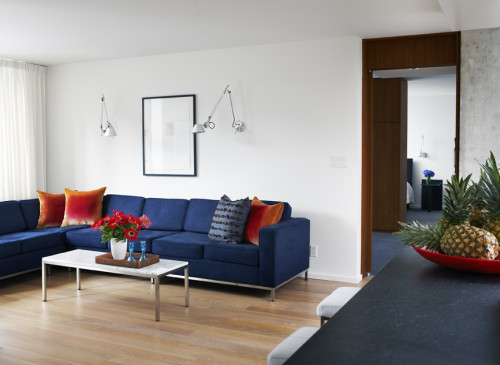
Oct 23, 2015
Have you ever wondered what fabric to use where? As a designer I’m always being asked about fabrics and where they should go.
‘What do you think of this fabric for my sofa?’
‘I really love this fabric for drapery, will it work?’
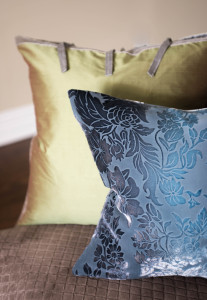 Recently, I was in a restaurant when a rather excited lady recognized me and came up to my table where I was sitting. She barely blurted out ‘hello’ and then proceeded to pull out
Recently, I was in a restaurant when a rather excited lady recognized me and came up to my table where I was sitting. She barely blurted out ‘hello’ and then proceeded to pull out
a fist full of fabrics from her purse.
(You’d be amazed how many of us walk around town with paint chips and fabric samples shoved in our bags.) Then, oblivious to all around her, went on to ask me what I thought of the textiles. I told her that they were very nice but that she had chosen all the wrong fabrics for all the wrong places.
I then invited her to book an appointment through my office so we can get the selections right for her.
After that encounter, it reinforced in me what I already know, that so many people, although well intentioned, often are blind as to what fabrics to use where.
Choosing soft linen for a sofa is okay but it may not give you the durability you need in your family room.
The same can be said for choosing upholstery fabric for drapery. It won’t ‘drape.’ More often than not, I have been hired after the fact when so many costly mistakes have been made.
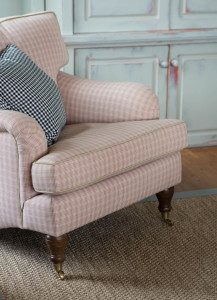 So, in an effort to help you make the right choices, I wantto share with you some simple things to look out for when choosing fabrics. When covering furniture, always look to upholstery weight fabric. In general, I love working with the wide selection of Robert Allen Fabrics myself.
So, in an effort to help you make the right choices, I wantto share with you some simple things to look out for when choosing fabrics. When covering furniture, always look to upholstery weight fabric. In general, I love working with the wide selection of Robert Allen Fabrics myself.
Keep in mind fabric that is specifically made to be used on furniture and is made of all types of cotton, linen, poly and silk and is priced accordingly. I always make sure I know the number of “rubs” a fabric can withstand. A very durable fabric will have anywhere from 50,000 to 100,000 “double rubs.”
This will be perfect for family room sofas and chairs, kitchen chairs, benches, desk chairs and kid’s rooms.
There is upholstery fabric that has less double rubs and is more delicate these can be used on furniture that needs less durability such as occasional chairs, living room sofas, dining room chairs, headboards and accent pillows.
Drapery weight fabric is different from upholstery weight fabric in that it is much lighter, generally speaking, and obviously gives a softer effect to your window treatments.
When properly constructed and lined silks, linens and cotton twills are all excellent options for drapery.
When choosing fabrics for your home always remember, suitability, appropriateness and your lifestyle.
Keep in mind too the type of fabric. Upholstery weight vs. drapery weight. 100,000 double rubs versus 10,000. Sofa vs. window. I know it may sound simple but so many get it so wrong.
So, now when you see me in a restaurant and go to reach into that bag of samples, know with confidence that what you can walk on by without question. But please do say hello!
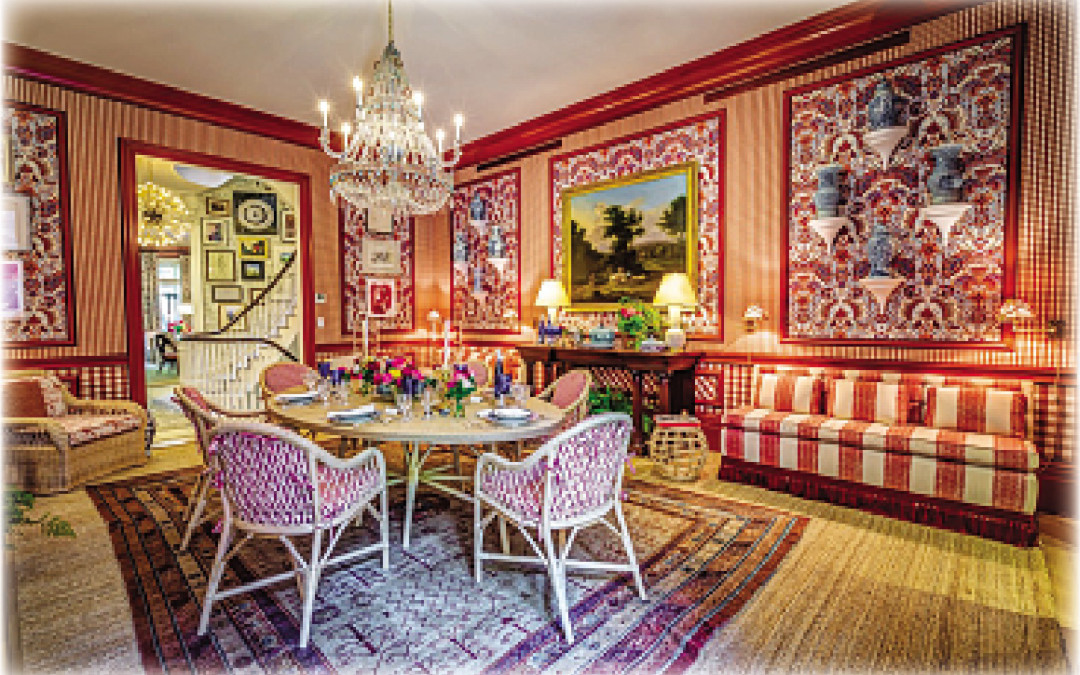
Jun 12, 2015
As I pen this installment of Go Design It, i’m happily ensconced in The Hamptons.
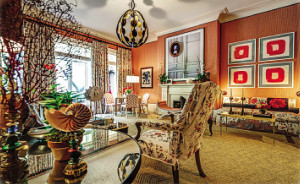 I come here every year for a while to source items for various design projects and generally get inspired by the understated, casual chic that I like to infuse into my work.
I come here every year for a while to source items for various design projects and generally get inspired by the understated, casual chic that I like to infuse into my work.
Part of this annual pilgrimage includes a stop in New York City to attend, what is in my mind, the most important design event in North America.
Each year, this is the 43rd edition, designers from all over the place are invited by The Kips Bay Boys and Girls Club (a charity that provides after school and enrichment programs for more than 10,000 talented young people) to create a room in one of New York most elegant and empty mansions.
This year it is the Arthur Sachs mansion on the upper east side. Its five stories have recently been brought back to life. Though many talented designers worked on this year’s house, I would like to mention my three favorite spaces.
The first is the central staircase that connects each of the five floors. Designer Philip Mitchell has taken an incredibly difficult space and turned it into a remarkable gallery on which he has hung paintings, drawings and sculptures from various periods in a neo-salon style — that is to say — stacking works of art one on top of the otherin what seems to be a very effortless way but in fact has been very carefully thought out.
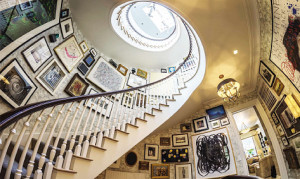 He did this all on top of a pale grey wallpaper containing forest scenes with stags by Mulberry Home for Lee Jofa. It is all truly jaw dropping!
He did this all on top of a pale grey wallpaper containing forest scenes with stags by Mulberry Home for Lee Jofa. It is all truly jaw dropping!
On the first floor directly off of the stairwell is the living room by designer Alessandra Branca. This room contains so many of my favorite things that I can’t mention them all.
But here i t goes. Contemporary art, mixed with antique slip-covered furniture, fabric covered walls, banquettes, coromandel screens, sisal carpets by Stark, dramatic lighting by
Vaughn all accented with gold metals and natural elements. Whew!
The overall effect is a supremely elegant, witty and original — a very comfortable space in which to relax and live luxuriously.
Across the landing from the living room is the dining room by Mark Sikes. I have to pause here and tell you that I spent so much time in this room that the show house volunteers must have thought I was casing the joint.
This room, to me, is true perfection. Inspired by the uber style icon Marella Agnelli, texture, pattern, color and originality come together to create an outstanding room.
As a designer myself, I can tell you emphatically that only a designer with tremendous confidence and elan can mix red ginghams by Schumacher with florals by Robert Allen along with blue and white china, contemporary art with an 18th century landscape and rattan garden furniture by Saone Britain.
The layers in this room are truly mind-boggling and bewildering in the best way possible. It is and will always remain an iconic room in the design world.
The Kips Bay Designer Show House runs until June 11, 2015. If you’re in New York, don’t miss it!
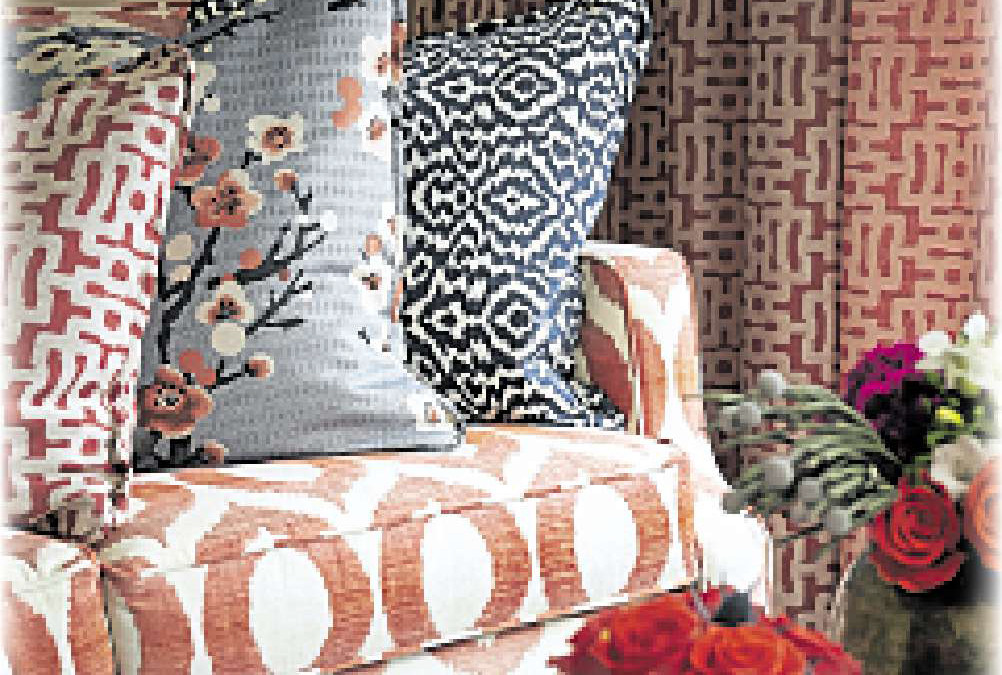
Apr 19, 2015
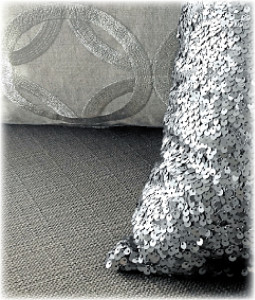 As the principal designer of a bustling interior design firm, I’m often asked a lot of questions about style, trends, design, and taste.
As the principal designer of a bustling interior design firm, I’m often asked a lot of questions about style, trends, design, and taste.
However, the most frequently asked question I hear is: “Where do you start when designing a room”?
My answer is almost always “with the fabric.” One of the best parts of my job is going to fabric showrooms, for me, they are places of inspiration and ideas.
I like to spread out different linens, velvets and silks intricate and simple, costly and attainable and pull together a look that I know my clients will love.
For me, fabric is the key that unlocks the door to a great looking room.
When you have a textile that’s dynamic and exciting you have a lot to work with.
I like to start with a patterned material with at least three to five colours. Perhaps a chinoiserie inspired linen like, fabulous JF Fabric Toiles or bold graphic silk/cottons.
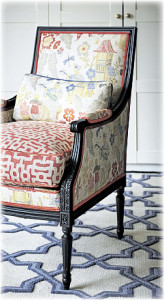 From the fabric’s palette, I can then select my wall colour, carpets, lamps, and develop other ideas for the look of the room.
From the fabric’s palette, I can then select my wall colour, carpets, lamps, and develop other ideas for the look of the room.
Mixing fabrics is very important. Be bold, confident and never boring. A boring room is the worst.
Stripes and solids, checks and prints and various textures add personality and keep a room alive and attractive.
If you’re not experienced in mixing fabrics keep a common element in mind such as colour, a motif or a natural reference.
And remember to include materials with texture; smooth and rough, shaggy and short, all will play a part in the success of a room.
I go by my own rule “if I like alone, it will work together”. Fabrics don’t all have to be super strong, in fact, I choose quite subdued colours and patterns if my clients are interested
in a quieter more understated space.
I always keep in mind the functionality of the room and my clients needs. A bedroom may inspire softer more restful fabrics where as the family room could be more playful and light hearted.
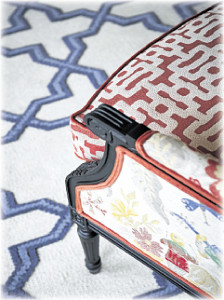 Where durability is a concern, I always use what’s appropriate. Linen for a family room sofa that kids and dogs use daily is not a great idea. Instead I opt for sturdy velvets or strong cottons.
Where durability is a concern, I always use what’s appropriate. Linen for a family room sofa that kids and dogs use daily is not a great idea. Instead I opt for sturdy velvets or strong cottons.
Speaking of sofas and fabric, I’m a big fan of patterned fabric on sofas. For too long, sofas have been a little too safe and frankly just boring.
A bold pattern is fun and unexpected and the pattern, if chosen carefully, will stand up to daily life and be so much more forgiving.
When I’m asked how to create a beautiful room I say “start with fabric”. It’s the foundation from which I build ideas and create the look my clients want.
I start with a key fabric then add more and more keeping in mind appropriateness and good taste, of course but balancing it with the boldness of confidence and the desire not to be boring.
Because the worst thing a room can be is boring!

 Recently, I was in a restaurant when a rather excited lady recognized me and came up to my table where I was sitting. She barely blurted out ‘hello’ and then proceeded to pull out
Recently, I was in a restaurant when a rather excited lady recognized me and came up to my table where I was sitting. She barely blurted out ‘hello’ and then proceeded to pull out So, in an effort to help you make the right choices, I wantto share with you some simple things to look out for when choosing fabrics. When covering furniture, always look to upholstery weight fabric. In general, I love working with the wide selection of Robert Allen Fabrics myself.
So, in an effort to help you make the right choices, I wantto share with you some simple things to look out for when choosing fabrics. When covering furniture, always look to upholstery weight fabric. In general, I love working with the wide selection of Robert Allen Fabrics myself.







Recent Comments